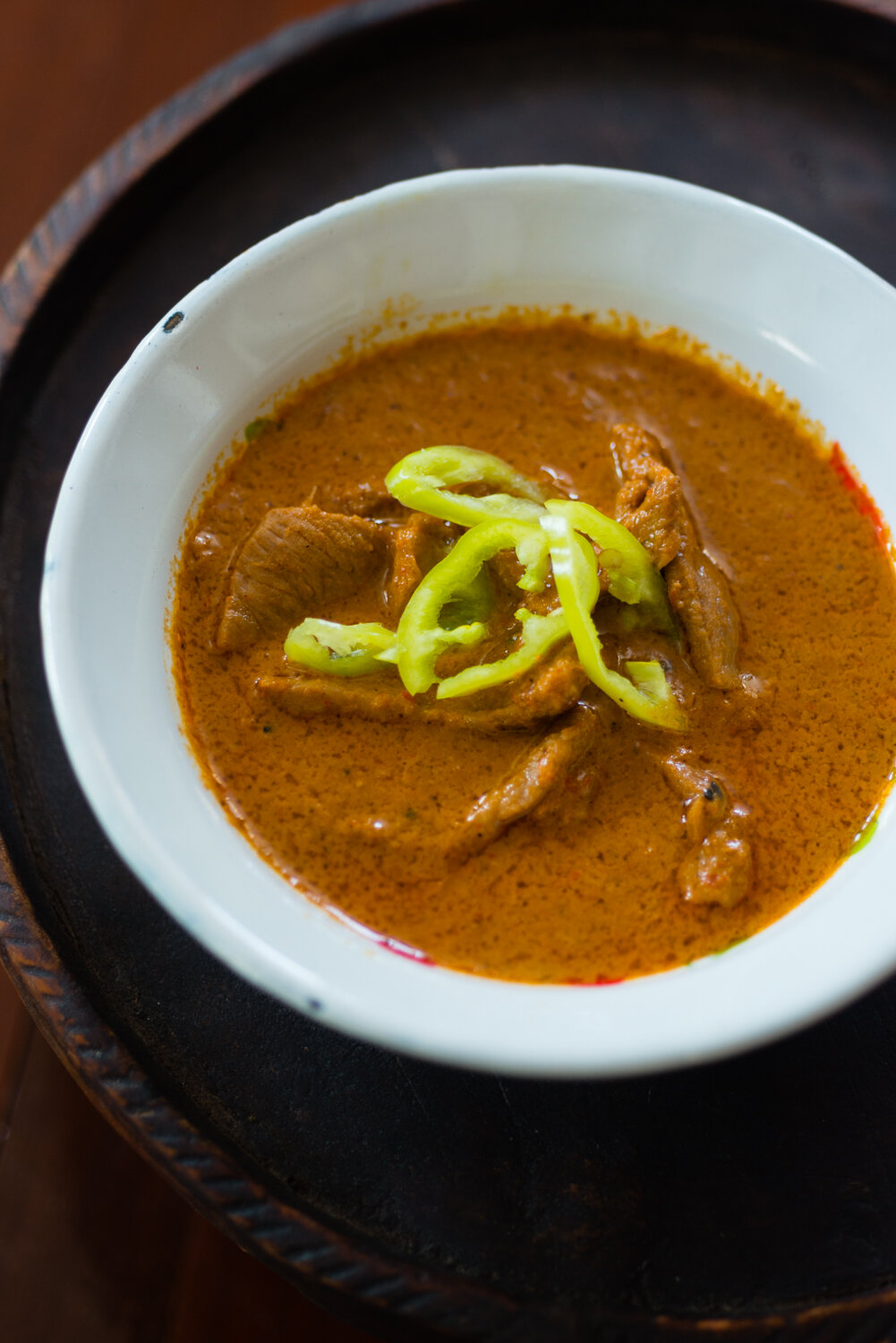As a guy who writes Thai cookbooks, I’m not supposed to say this, but cooking Thai food can be kind of a pain in the ass. Making a curry paste from scratch requires a zillion ingredients that, if you live alone like I do, inevitably leads to waste. The process is time consuming, messy and fiddly. And on a personal level, I tend to associate cooking Thai food with work, and having lived in Thailand more than 20 years now, these days I take a lot of pleasure in cooking and eating non-Thai food.
But with some time on my hands (and perhaps also a desire to keep my skills sharp), I thought I’d dip back into Thai cooking. And my first instinct was to try something I’ve long wanted to do: Cook a dish from Mae Khrua Hua Pa (แม่ครัวหัวป่าก์). Written by Thanphuying Plian Phassakorawongse (Lady Plian from here out), a noble in Bangkok during the beginning of the 20th century, it’s generally considered the first Thai cookbook. The culinary world described in it is utterly fascinating – cooking techniques, dishes and combinations of ingredients that have long disappeared from Thailand (the instructions to cook long-grained rice alone span eight steps and involves kitchen tools most contemporary Thais have probably never even heard of). But the recipes are often unclear and/or vague, with ingredient amounts non-existent or seemingly arbitrary. And as many of these dishes haven’t been made in a century, we have no idea, really, how they should taste or smell or look or feel. Simply put, cooking from this book is a challenge, as it requires some background and familiarity with Thai cooking (and Thai language skills; I don’t think it’s been translated into English). Which means that any dish cooked from the book is equal parts Lady Plian’s and the cook’s. I like this; it’s cooking that involves both a sense of history and creativity.
I’m a fan of rich, pleasantly oily dishes, so I started with this recipe, simply titled Kaeng Nuea Wua (แกงเนื้อวัว), Beef Curry, from the first book of the series (there are a total of five). I’ve included the original Thai here, and the English translation has my amounts, and my comments in brackets. Warning, it makes a lot – probably enough for six people – but I suspect that it keeps well.
แกงเนื้อวัว
เป็นเครื่องปรุง – พริกแห้ง หนัก ๓ บาท ตะไคร้หนัก ๑ สลึง ข่าหนัก ๑ ไพ กระเทียมหนัก ๒ บาท หัวหอมหนัก ๑ บาท รากผักชีหนักสลึงเฟื่อง พริกไทยหนัก ๑ สลึง ลูกผักชีหนัก ๑ เฟื้อง ลูกยี่หร่าหนัก ๒ ไพ จันเทศหนัก ๒ ไพ เกลือหนัก ๒ สลึง เยื่อเคยหนัก ๑ สลึง ผิวมะกรูดหนัก ๑ ไพ ของเหล่านี้ล้างน้ำอย่าให้เปื้อนแล้วเทลงครกโขลกให้ละเอียด น้ำปลาดี น้ำตาลหม้อพอควร เนื้อวัวเอาแต่เนื้อมานั่นเป็นชิ้นบางๆ ล้างน้ำให้สะอาดคั้นน้ำให้สะเด็ด พักไว้ก่อนและห่อใบมะละกอไว้
วิธีทำ - เอาหม้อตั้งไฟขึ้นเอาน้ำมันหมูหนัก ๒ สลึงเทลงในหม้อ แล้วเอากระเทียมทุบกลีบแกะเอาแต่เนื้อโรยลงในหม้อผัดไปกับน้ำมันหมูให้หอม แล้วเอาเนื้อวัวที่บิดไว้รวนลงในหม้อแกงผัดไปให้แห้งน้ำรวนเนื้อแล้วตักขึ้น เอามะพร้าวมาขูดคั้นหัวกะทิหนัก ๔๐ บาท เทลงในหม้อขึ้นเคี่ยวจนเดือดคนไปให้แตกมันแล้วเอาหางกะทิละลายพริกขิงแต่พอข้นๆ ตักหยอด ลงในหม้อกะทิแล้วผัดพริกขิงไปให้ทั่ว จึงเอาเนื้อวัวที่รวนไว้ลงคนไปปิดฝา ให้เดือดแล้วเอาน้ำหางกะทิล้างครกพริกขิงหนัก ๑๒ บาท เทลงในหม้อแกงแล้ว เอาน้ำปลาดีหนัก ๒ สลึงเหยาะลงในหม้อ น้ำตาลเดาะลงแต่นิดหน่อ อย่าให้หวานนักเมื่อจืดเต็มชิมดูตามชอบแล้วตกลงชามไปตั้งให้รับประทาน
Beef Curry
15g [large] dried chilies [chopped coarsely]; 70g lemongrass [whole stalks; exterior layer discarded, pale inner part sliced thinly]; 40g galangal [peeled and sliced thinly]; 60g garlic [small cloves; discard coarse exterior and stalk but no need to peel]; 25g shallots [peeled and sliced thinly]; 4 coriander roots [chopped]; 1 teaspoon black peppercorns; 1 teaspoon coriander seeds [toasted until fragrant]; 1 teaspoon cumin seeds [toasted until fragrant]; [about] ⅛ teaspoon nutmeg; ½ teaspoon salt; 1½ tablespoons shrimp paste; 1 teaspoon [chopped] kaffir lime zest; wash these ingredients and pound to a fine paste with a mortar and pestle [traditionally, Thais would start with the dry ingredients moving toward the “wet” ones, going in this approximate order: salt, chili, dried spices, lemongrass, galangal, coriander roots, garlic, shallots, kaffir lime zest, shrimp paste]; good quality fish sauce; an appropriate amount of palm sugar; 500g lean beef, sliced thinly, washed, dried, and wrapped in the leaf of a papaya tree
Directions
To a pot over a flame [high], add 2 tablespoons of lard. To the lard, add garlic [I used four big cloves, about 15g] that has been peeled and crushed, and fry until fragrant. Add beef, sear, fry until any moisture has evaporated, and remove. Add 4 cups of coconut cream and stir [occasionally] until the cream reaches a boil and a layer of oil rises to the top [it took about 15 minutes of rapid boiling before the oil even began to separate]. Combine 1 cup of coconut milk with the curry paste, add to the pot and fry [I allowed this mixture to boil rapidly and reduce for another 10 minutes or so, at which point it was mellow, and fragrant, and the oil rose to the top]. Add the beef and 1 cup of coconut milk, and put a lid on the pot. When the mixture reaches a boil, add 4 teaspoons of fish sauce [or to taste] and a bit of sugar [I added about 40g of palm sugar], but don’t season too sweet. Taste and adjust the seasoning to your preference. Remove from the heat and eat.














